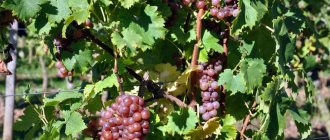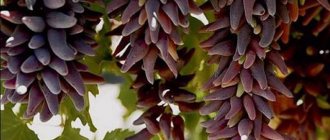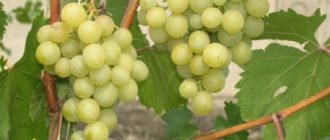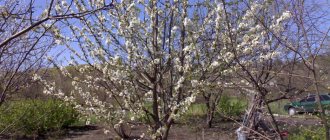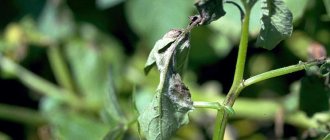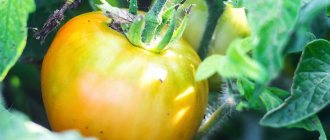| General information about the Tason variety | |
| Tasona parent couple | Italy x Zorevoy |
| Author of the variety: | VNIIViV named after. ME AND. Potapenko, Russia |
| Main characteristics of Tason | |
| Purpose: | dining room |
| Ripening time: | super early |
| Productivity: | high |
| Taste: | nutmeg |
| Color: | pale pink |
| Frost resistance: | up to — 22°C |
| Description of a bunch of grapes | |
| Bunch weight: | 500-800 gr. |
| Bunch density: | medium-dense |
| Description of grapes | |
| Berry shape: | oval |
| Berry weight | 6-7 gr. |
| Diseases | |
| Disease resistance: | Not resistant to fungal diseases, weakly affected by mildew and oidium, relatively resistant to gray rot. |
Good taste is one of the most important advantages of grapes, not counting the ease of caring for them. The most valued grapes, especially in wine making, are those that have a rich, sweet, and most importantly, muscat taste. One of these varieties with pronounced notes of muscat is the Tason variety. True connoisseurs of these berries equally love to consume it both raw and to make aromatic, tart table wine from it.
Advantages and disadvantages
Like any other variety, “Tason” has its pros and cons.
Pros:
- Early ripening of berries
- Bright nutmeg taste.
- Doesn't pea.
- High yield.
- The grapes ripen evenly.
- Attractive presentation.
- Frost resistance.
- Good transportability.
Minuses:
- Not resistant to fungal diseases.
- The vine may be overloaded with harvest.
- Damaged by wasps and birds.
- Depending on weather conditions, the berries may color unevenly.
- Requires shelter for the winter.
Where
This popular variety was bred by workers of the All-Russian Research Institute of Viticulture and Winemaking Y.I. Potapenko (VNIIViV) through long and labor-intensive breeding work. Tason is an artificially bred hybrid variety. In order to get a new variety, professional breeders crossed Italy grapes with Zoreva. The Tason grape variety quickly gained its popularity, as there is something to love about the variety. Like all other grapes, this variety loves the sun, warm weather, and the south. It can also grow in more northern regions, for example, in the Moscow region. But in order for this to happen, you need to spend much more time and effort caring for this variety. We will look at the description of the variety in more detail below.
Main characteristics
In terms of the totality of its qualities, Tason has no equal among Muscat grape varieties.
Ripening period
According to the ripening period, the hybrid belongs to varieties with a very early ripening period. From the growing season to harvest, about 100-110 days pass.
Reference! The ripening period does not depend on weather conditions. Gardeners not only in the southern regions, but also residents of the Moscow region and Leningrad region note that grapes ripen as early as the 20th of July. If you do not pick the berries right away and let them hang on the bushes for a while, they will become sweeter and acquire a richer nutmeg flavor.
Bush
“Tason” bushes are vigorous. They have a strong root system and powerful vines. The leaves are dark green, consist of five lobes and are strongly dissected. Thanks to the bisexual flowers, grapes do not need additional pollination.
When grown in the cool climate of the middle zone, it is recommended to form the “tason” as a covering grape. The most suitable for it are fan and semi-fan multi-sleeve molds. You can form a bush in the form of a two-armed cordon.
In warm regions where winter shelter is not required, this tall hybrid can be grown on an arch or with a high trunk.
Bunches and berries
The bunches of the “tason” are cylindrical-conical in shape with an average density of berries. The brushes are quite large, weighing 500-800 grams, sometimes ripening specimens weighing 1.2 kg. Thanks to the massive clusters and unusual color of the berries, the bushes look very bright and attractive.
Translucent “tasona” berries are white and pink. In the sun's rays, the grapes acquire a tan, but in the shade they do not color and remain white. The fruits are quite large, up to 25 mm long and up to 18 mm wide.
When exposed to light, under the thick skin, elastic flesh of a golden amber color is visible. The pulp contains from 3 to 5 small seeds, which are practically not felt when eaten. Sugar content of berries is 19-21%, acidity is 5-6 g/l.
Taste
Thanks to its noticeable nutmeg taste and early appearance on sale, “tason” is quickly sold out in the markets. It earned a tasting score of 8.2 points and is considered one of the most delicious varieties of early ripening grapes.
Despite the fact that the skin is quite dense, it is practically not felt when eaten. Under the skin lies a fleshy and crispy amber flesh. The taste of the berries is sweet, harmonious, nutmeg. Some connoisseurs noticed strawberry notes and honey aroma in the taste.
Productivity
The vine bears good fruit and ripens almost completely. Two clusters ripen on one shoot; sometimes an adult grape bush can produce a harvest of up to 40 bunches. The total weight of the collected fruits averages 20-35 kg.
Tason grapes: variety description, photo, disease resistance
According to scientists, Tason is very susceptible to diseases and is affected by pests. However, many gardeners tend to disagree with this statement. The most terrible enemies are powdery mildew, oidium, phylloxera. To prevent the plant from getting sick, it needs proper care and timely preventive measures.
Tason grapes are susceptible to fungal diseases and parasites. To avoid the negative consequences of their impact, standard preventive spraying should be carried out in a timely manner. In general, gardeners have noticed that if timely fertilizing and preventive maintenance are done, the plant is resistant to any pests and the harvest is preserved intact. Otherwise, there is a risk of being left not only without berries, but also losing the entire bush.
Comparison with analogues
How you want to taste ripe juicy grapes on a hot summer day! It is especially pleasant when it is grown on your own plot. To taste the fruits of the new harvest as early as possible, plant early-ripening grape varieties that will delight you with sunny berries by the end of July.
“Tason” undoubtedly occupies a leading position among very early varieties.
| Sign | Variety | |||
| Tason | Libya | Laura | Transfiguration | |
| Ripening period | 100-110 days | 105-110 days | 110-115 days | 110-115 days |
| Frost resistance | up to -22°С | up to -21°С | up to -25°С | up to -21°С |
| Yield per bush | up to 35 kg | up to 30 kg | up to 20 kg | up to 20 kg |
| Bunches | 0.5-0.8 kg | 0.8-1.2 kg | 1 kg | 0.7-1.5 kg |
| Taste | bright nutmeg | nutmeg aroma | light nutmeg | harmonious, dessert |
| Color | pink-white | pink | pale green | light pink |
| Disease resistance | low | average | average | average |
| Shelf life | up to 3 months | up to 1 month | up to 2 months | up to 6 months |
| Sugar content | 19-21% | 18-23% | 20% | 17-19% |
| Acidity | 5-6 g/l | 6-7 g/l | 6-8 g/l | 6-7 g/l |
Reproduction
The easiest way of propagation for me is rooting cuttings. How to store cuttings is indicated in a separate article; there is also a separate article on how to germinate them. As for Tason, this is probably the most optimal option, the form is quite common, and it won’t be difficult to get a cutting from the winegrowers of your city.
If your bush is already growing and you need 1-2 more, then the easiest way is to make layering. The method of propagation by layering is also discussed in a separate article.
Useful properties and scope of use
Grapes contain a huge amount of microelements beneficial for the human body. These include vitamins, minerals, and fruit acids. Grapes have a positive effect on the functioning of the gastrointestinal tract and cardiac activity, it strengthens the immune system and improves mental activity.
Important! Due to the fairly high sugar and acidity content, grapes should be consumed with caution by people suffering from diabetes and those with high stomach acidity. The rather high calorie content does not make this product dietary. If consumed in large quantities, it may contribute to weight gain.
Many people like the table grape variety “Tason” fresh. However, due to the brightness of Muscat, most of its fruit is used to make elite wines. Amateur winegrowers can preserve the harvest by making preparations for the winter: juices, jams, compotes, raisins. Winemakers can please loved ones and guests with excellent homemade wine.
What type does it belong to?
Tason is a table hybrid subspecies of pink grapes. Pink varieties also include Angelica, Gurzuf pink and Flamingo.
The variety is very popular because of its hardiness and excellent commercial qualities - the berries do not crack, do not rot, and withstand storage and transportation well.
It is in high demand among buyers both in the form of berries and seedlings. We love it very much in its natural form - because of its unobtrusively sweet, aromatic taste with a rich aftertaste with notes of rose, honey, nutmeg and strawberry. It is also used in bouquets of elite table and dessert wines.
The varieties Descendant Rizamata, Helios and Zarya Nesvetaya are also often used in blending.
Features of cultivation
Tason grapes are excellent for cultivation in areas with short and cool summers. Thanks to its rapid ripening and unpretentiousness, gardeners receive abundant harvests by the end of July.
Landing
When purchasing seedlings, pay attention to their quality. The cuttings should not show signs of disease or damage. The roots of the plant must be intact and strong.
“Tason” can be planted both in spring and autumn. Experienced winegrowers recommend preparing the planting site in advance. So, when planting in spring, the soil is prepared in the fall. If this is not possible, then it is recommended to prepare at least 2 weeks in advance.
Landing rules:
- Dig a hole 80 cm deep and wide.
- The bushes are planted at a distance of 1.5 m from each other, and there should be 3 m between the rows.
- If groundwater is close, it is worth pouring drainage: expanded clay, crushed stone or brick chips.
- A mixture of chernozem and fertilizers containing potassium and phosphorus is poured into the bottom of the hole.
- A layer of black soil is poured on top and left in this form for some time so that the fertilizers are absorbed into the soil.
- Now you can place the seedling in the hole, straighten its roots and add soil.
- The soil around the plant is lightly compacted and watered abundantly - about 20 liters per bush.
To prevent moisture from evaporating too much, the soil around the bush is mulched using sawdust, humus, straw, spruce branches, spunbond and other materials.
Place and soil
“Tason,” like all grape varieties, loves warmth and sunlight. Therefore, when growing in a cool climate, it is worth choosing the southern part of the site, which is well lit by the sun most of the day. If there is a lack of light, the berries of this hybrid will not turn pink and will remain white. More details about the ideal place for grapes in a separate article.
This grape loves light, loose soil. It is undemanding to the composition of the soil and can show excellent results even on infertile lands.
Watering and fertilizing
The first time after planting, watering must be carried out daily. Provided that the weather is fairly dry and there is no rain.
Reference! It is better to water the grapes in the evening so that the sun's rays do not burn the plants. The water should be settled and warm.
During the season there are 4 main irrigations:
- After flowering.
- During the formation of berries.
- After the harvest.
- Before sheltering for the winter.
If the season turns out to be dry, then the amount of watering is increased.
Mature grapes need regular feeding. Organic fertilizers are applied after flowering, during the formation of berries. Before sheltering for the winter, the bushes are fertilized with preparations containing potassium. And also during the season, foliar feeding is carried out by spraying with solutions of nitrogen, potassium and phosphorus fertilizers. Spraying is often combined with treatment against diseases and pests.
Trimming
Pruning of the “shade” is carried out both to form the required shape of the bush and to lighten it. If the vine is very dense, it does not transmit sunlight well, ventilation is impaired and the plant becomes vulnerable to diseases.
In the spring, you need to remove shoots damaged during the winter and frozen out. In the summer, green pruning is carried out to regulate the density of the bush. In this case, all unnecessary shoots and stepsons are removed.
The main pruning is carried out in the fall, after the leaves have completely fallen. “Tason” can withstand a heavy load, however, the number of vines must be normalized so as not to overload the bush. 30-40 shoots and 10-12 eyes are left on each plant.
Reference! It will take 3-4 years for the vine to form into a fan.
Diseases and pests
“Tason” has low resistance to fungal diseases. However, with proper cultivation techniques and regular preventive measures, damage to the vineyard can be avoided.
To protect plants from fungal infections, preventive spraying is carried out with fungicides, such as: Quadris, Topaz, Horus. Treatment can be combined with watering.
Birds, which are not averse to eating juicy sweet berries, can cause great damage to the crop. As practice shows, installing various repellers gives a short-term effect. The most successful protection is to put a fine-mesh synthetic net on the bushes or separately on each bunch.
Wasps can also cause considerable harm. To get rid of insects, containers with a mixture of sweet syrup and insecticides are placed near the vineyard.
Shelter for the winter
This hybrid has good frost resistance and can withstand temperatures down to -22°C. Thanks to this, the southern plant is successfully grown in temperate climates. However, in the conditions of the Central region and Siberia, these grapes should be covered for the winter, because Winter temperatures in these areas usually fall below the maximum permissible level.
Sheltering is done in the fall, when the leaves have fallen. First, the grape bushes are pruned and fertilized to increase immunity. Next, the vine is removed from the trellis, tied and laid on the ground. You can pre-mulch the soil under the vine. Any materials available to you are suitable for shelter: earth, straw, spruce branches, agrofibre, boards, etc.
Harvest storage
The “tasona” harvest can remain on the vine without losing its qualities for up to 2 months. The fruits, ripe at the end of July, hang well until autumn, acquiring an even more pronounced nutmeg flavor.
The cut bunches are stored in the basement or refrigerator for up to 1 month. The longest grapes can be stored are suspended in individual clusters, in a dry and cool basement. In such conditions, the freshness of the berries can be preserved for 2-3 months.
How to plant correctly
Seedlings are purchased from nurseries located in the same climatic zone as the garden plot.
Recommendations for choosing deadlines
Experienced gardeners recommend planting the crop in the spring. Depending on the region and climatic conditions, this may be the end of March or April. When planted in spring, grape bushes have time to take root well and develop before the onset of frost.
Site selection and preparation
The area for planting Tason grapes should be well illuminated by sunlight. If there is not enough sun, the berries will be pale green in color and not as sweet and aromatic as stated in the description.
The bushes grow powerful, so there is no need to plant other plants close to them.
The selected place is cleared, dug up, and fertilized six months before planting the crop. At the same time, you can dig holes 80 centimeters deep and 1 meter in diameter. Compost, rotted manure, and mineral fertilizers are laid out in them.
How to select and prepare planting material
When choosing a seedling, you need to pay attention to a healthy vine and a well-developed root system. There should be no scratches, dents, or new growths on the bushes. If the roots dry out a little during transportation, the seedling is dipped in a bucket of warm water for several hours.
Planting scheme
A distance of at least 1.5 meters is left between the bushes. The distance between rows is 2-3 meters. Planting Tason grapes is done as follows:
- a third of fertile soil is poured into a pre-dug hole;
- a seedling is installed in the middle;
- 2-3 buckets of water are poured into the hole;
- the remaining substrate is added.
The soil is compacted a little, the tree trunk circle is covered with mulch.
Cultivation regions
The Tason grapes were selected for cultivation in southern conditions. But thanks to its taste and high yields, it was expected that gardeners in the Central region began to cultivate it. Thanks to its good frost resistance, this hybrid is successfully grown not only on the lands of the Crimea and the Krasnodar Territory. Gardeners in the Moscow region and even the Leningrad region note excellent yields and taste, indistinguishable from the southern “tasson”.
Reviews
The taste is simply amazing, number 1 on my list. Alexander, Kyiv
One drawback is the covering. This year the first harvest is 6 kg (in the past - the signal brush on the 2nd year was not so impressive), the largest brush is 850g, the color and taste are incomparable! Gennady, Ochakov
The variety is a pleasure! Good in every way! It overwintered well, with standard treatments it shows good resistance, it ripens very early, the vine ripens perfectly, a beautiful bunch is around 500g (for now), nothing had to be rationed - everything in moderation: one or two bunches per shoot, the most beautiful harmonious muscat - one of the best tastes on my site. Hangs on the bush for a long time - the taste does not deteriorate. Tatiana, Belgorod
Aftercare for grapes
Caring for Tason grapes is not burdensome, although it does require some effort.
The variety needs frequent watering, but excessive waterlogging of the soil can lead to root rotting. Typically, grapes are watered 4 times per season, and it is necessary to use water at room temperature. To better retain moisture in the soil, it is recommended to mulch the tree trunks of the bushes. Peat, sawdust and dry grass are suitable for this. Also, periodic weeding around the grapes will not be superfluous.
Fertilizers are applied 3 times per season:
- The first root feeding occurs in the first days after the bushes begin to flower. Any organic fertilizer will do.
- As the berries begin to ripen, a second feeding is introduced. During this period, the soil is enriched with phosphorus.
- The last time the plants are fed is in the fall. For this, potassium salts are used, which increase the frost resistance of the bushes. If necessary, potassium can be replaced with ash. Nitrogen at this time will harm the grapes.
Grape pruning
Pruning the vine stimulates the growth of berries and increases the yield of the bushes. The bushes are formed in such a way that the grape bunches receive a sufficient amount of light. Usually about 35 eyes are left on one plant (5-8 on one shoot).
The maximum load for the Tason variety is 40 shoots per bush.
Protecting crops from birds and insects
Tason grapes attract wasps and birds. To protect the crop from birds, the bunches are covered with special mesh bags made of rigid mesh, but they will not save you from insects. Sticky traps are used to combat them. It is also recommended to seal holes in the support posts that support the grapes, as wasps like to make nests in them.
Important! Some gardeners deliberately kill wasps on their property, but they are beneficial by killing aphids
Preparing the crop for winter
For the winter, only mature shoots up to 15 cm thick are left on the grape bush, with the optimal number of eyes being 12-15 pieces. Summer shoots cannot survive the winter, so they are cut out.
The trimmed vine is placed on a bed of dry leaves or straw. The top of the bush is covered with spruce branches, leaving gaps at the ends for ventilation. To protect grapes from rodents, the soil nearby is treated with special chemicals.
Important! Grapes should not be covered with plastic film for the winter, as it contributes to the formation of the greenhouse effect.
